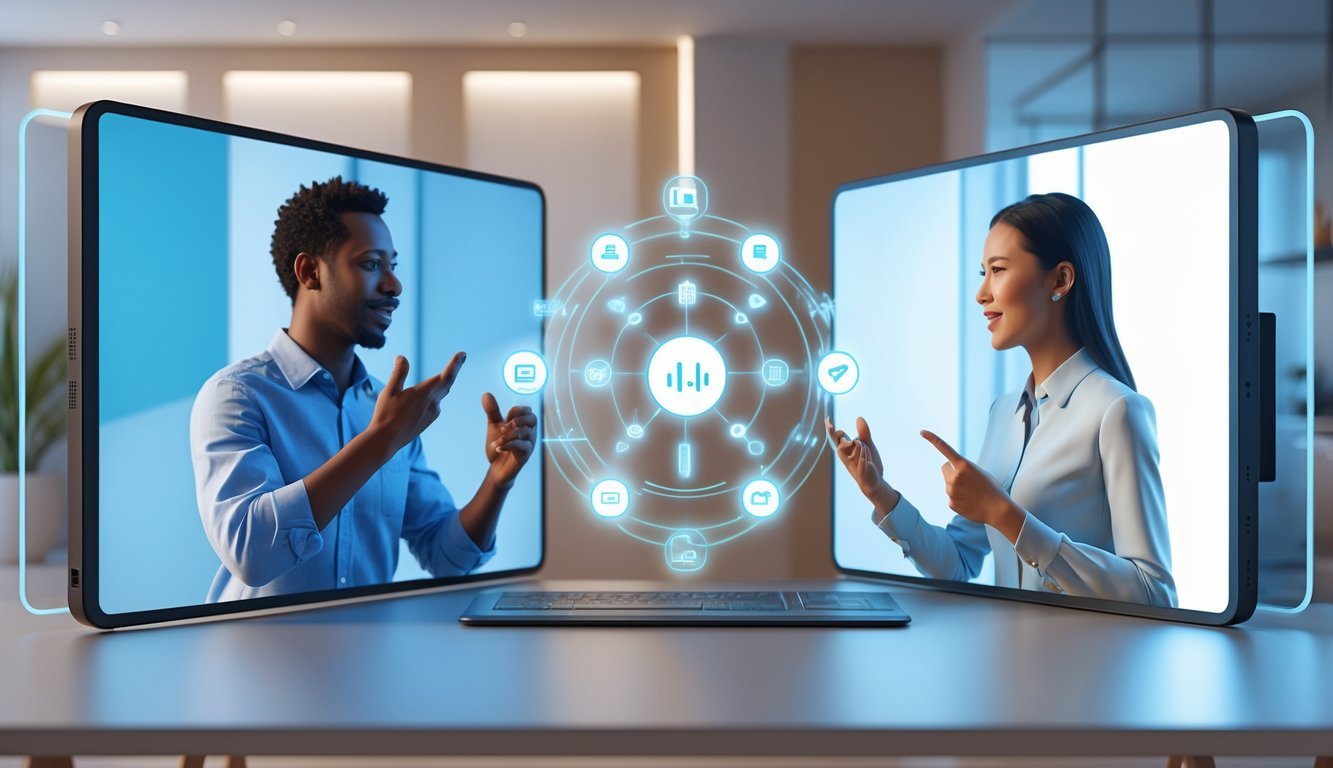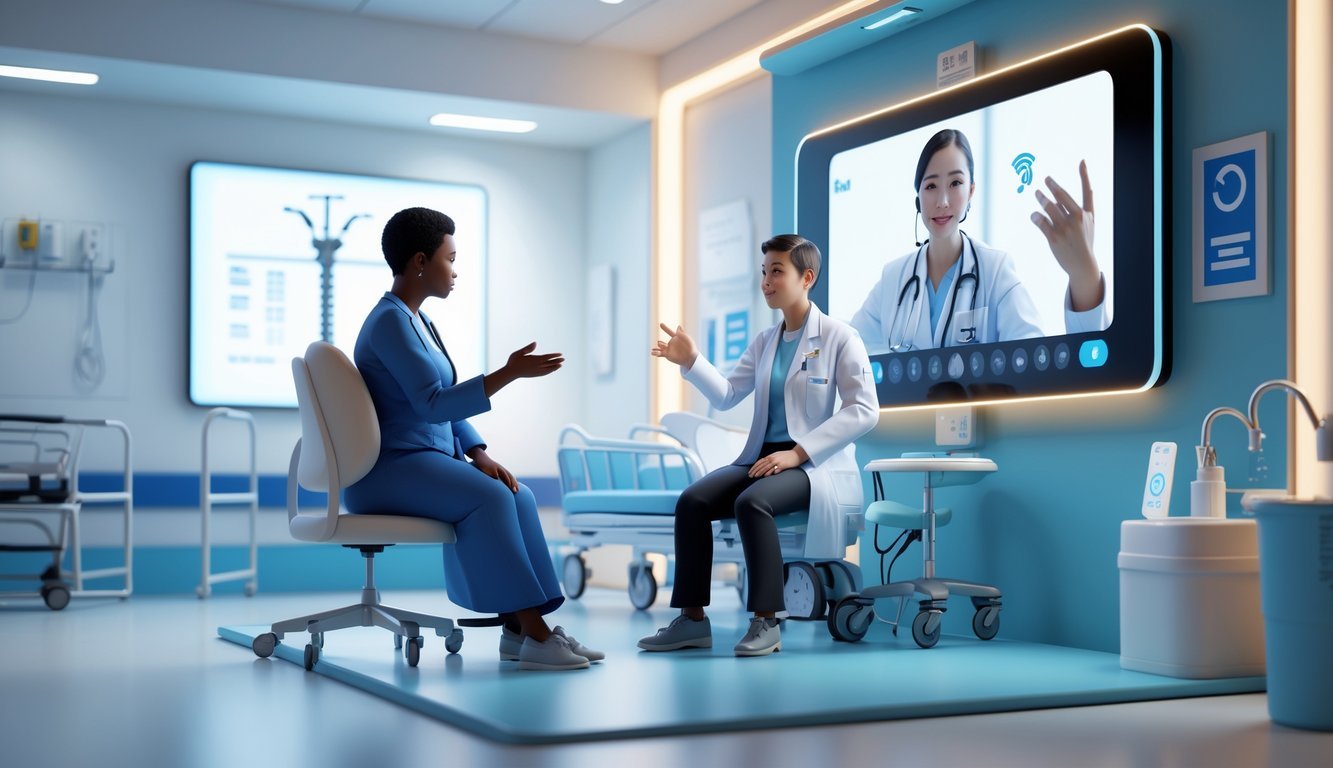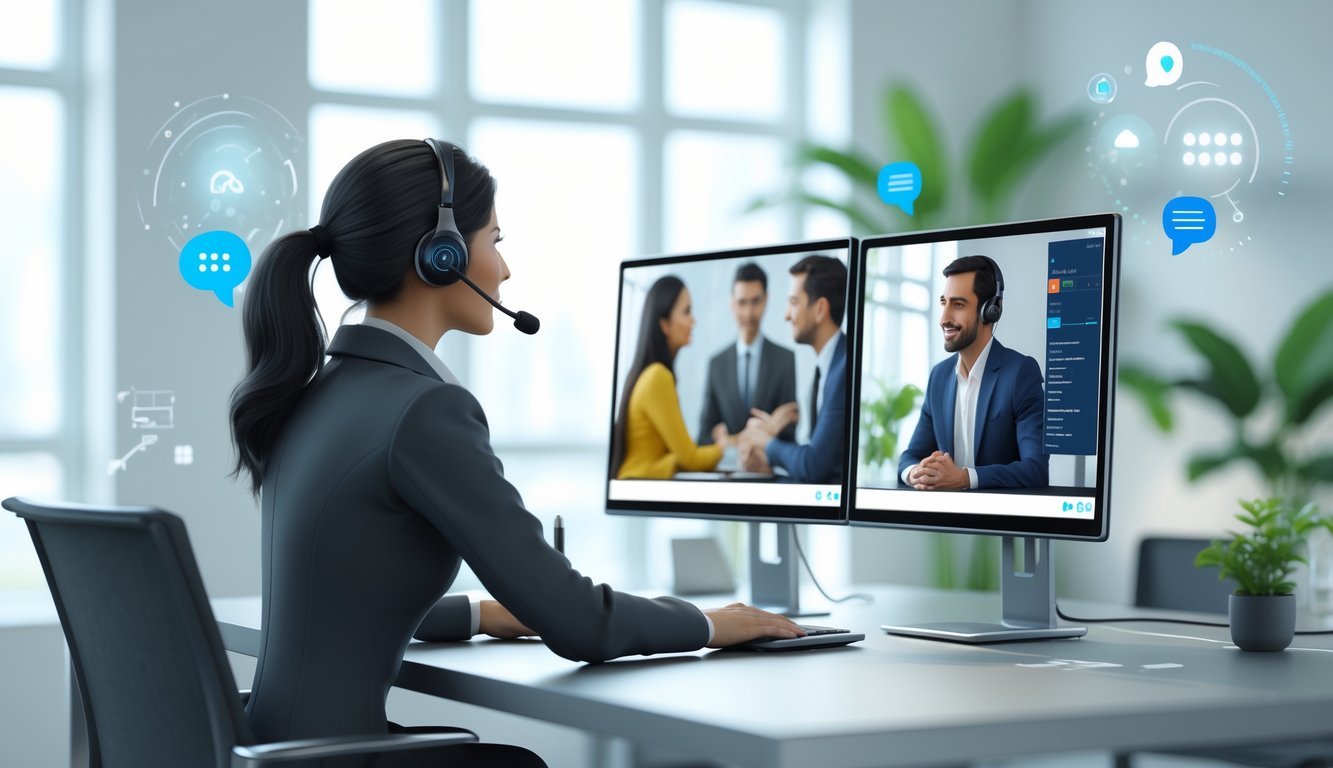Video remote interpreting has really changed the way people communicate across language barriers in healthcare, legal settings, and social services. This technology connects trained interpreters with patients and providers through secure video calls, making professional language services available pretty much instantly.
You can get professional interpretation services within 20 seconds using easy-to-use apps, and users are just as happy with it as with in-person interpreting. Plus, it cuts costs and improves accessibility.

Healthcare facilities now rely on video remote interpreting more than ever to serve diverse patient populations. Remote interpreting really took off during the COVID-19 pandemic when hospitals needed safer ways to communicate without physical contact.
Major medical centers now offer interpretation services in hundreds of languages. That means patients can get proper care, no matter what language they speak.
This technology helps fix serious communication gaps that affect patient safety and treatment. Language barriers can cause longer hospital stays, medication errors, and unhappy patients.
Professional video interpreting systems give reliable and secure connections. They help prevent liability risks and support safety for both patients and staff.
Key Takeaways
- Video remote interpreting connects professional interpreters with patients and providers through secure video tech in under 20 seconds
- Healthcare facilities use this service to break down language barriers that can lead to medical errors and bad outcomes
- The technology is a cost-effective alternative to in-person interpreting and keeps users satisfied
Core Concepts of Video Remote Interpreting Service

Video remote interpreting connects people who need language help with professional interpreters through real-time video. This system isn’t quite like traditional phone interpreting or face-to-face meetings, especially when it comes to visual cues and legal requirements.
What Is Video Remote Interpreting (VRI)?
Video remote interpreting gives you real-time language interpretation through video conferencing. Professional interpreters work from different locations to help people talk across language barriers.
VRI runs on secure internet connections. Users connect to interpreters using computers, tablets, or smartphones with cameras and microphones.
Key features of VRI:
- Live video and audio
- Certified interpreters
- Tons of language options
- 24/7 service in many cases
- HIPAA-compliant platforms for healthcare
Healthcare facilities use VRI for patient consultations. Legal offices use it for client meetings and court proceedings.
The technology lets interpreters see facial expressions and body language. That visual piece helps them interpret more accurately than voice-only services.
How Video Remote Interpreting Works
The VRI process starts when someone asks for interpreter services through a platform or provider. The system finds an available interpreter who speaks the right languages.
Users can access VRI through dedicated apps, web browsers, or special hardware. The interpreter pops up on screen and can see and hear everyone in the conversation.
Typical workflow:
- User requests a specific language pair
- System matches them with a qualified interpreter
- Video connection opens for everyone
- Interpretation happens in real time
- Session ends when everyone’s done
You don’t need much tech. Just a device with a camera, a mic, and solid internet. Most smartphones and computers work just fine.
Remote interpreting sometimes brings up concerns about communication quality, mostly because of tech hiccups. Bad sound or spotty internet can mess with interpretation accuracy.
Differences Between VRI, TRI, and In-Person Interpreting
VRI, telephone remote interpreting (TRI), and in-person interpreters all have their own ups and downs.
Video Remote Interpreting gives you visual communication through screens. Interpreters can see gestures, facial expressions, and even written stuff. But sometimes, the camera angle or screen size limits what they can catch.
Telephone Remote Interpreting only has audio. It’s fine for simple chats but not so great for complex medical issues or emotional conversations.
In-person interpreters get the full picture. They see everything, move around, and pick up on stuff remote interpreters might miss.
| Service Type | Visual Cues | Cost | Availability | Best For |
|---|---|---|---|---|
| VRI | Limited visual | Medium | High | Routine consultations |
| TRI | None | Low | Highest | Simple conversations |
| In-person | Full visual | High | Limited | Complex situations |
Research tells us that interpreters think both video and telephone interpreting make communication harder compared to face-to-face meetings. Video does better than telephone, but still doesn’t quite match in-person quality.
Legal and Compliance Requirements: ADA and Disability Rights
The Americans with Disabilities Act (ADA) says lots of organizations have to provide interpreter services for people with hearing impairments or limited English. VRI can help organizations meet these legal rules.
ADA requirements for VRI:
- Qualified interpreters with the right certification
- Communication as effective as in-person
- Proper tech and equipment
- Reasonable response times
Healthcare providers must offer interpreter services under ADA Title III. VRI counts as an acceptable accommodation if it actually gives communication equal to in-person interpreting.
Courts and legal offices sometimes need in-person interpreters for certain cases. Others accept VRI if the tech quality is up to snuff.
Disability rights advocates say remote services have to really provide equal access. If video quality is bad or there are delays, organizations might still violate ADA rules—even if they tried to help.
Organizations need to check if their VRI setup meets legal standards. That means testing equipment, training staff, and having backup plans for tech problems.
Video Remote Interpreting in Healthcare and Accessibility

Video remote interpreting has changed how healthcare teams communicate by providing real-time language help through digital platforms. It’s especially important for deaf and hard of hearing patients who rely on visual communication.
Healthcare organizations now juggle service quality, cost management, and workforce challenges while working to make medical care fair for everyone.
VRI for Deaf and Hard of Hearing Accessibility
Video remote interpreting is a huge help for deaf and hard of hearing patients getting healthcare. Unlike audio-only solutions, VRI lets people use the visual communication needed for sign language.
Patients can talk with medical professionals through real-time video. They don’t have to wait for in-person interpreters for regular appointments or emergencies.
Healthcare accessibility for deaf patients has gotten a lot better with VRI. Patients can get services right away, instead of waiting around.
Emergency departments especially benefit from VRI. In critical situations, video tech gives instant access to qualified interpreters any time, day or night.
The visual side of VRI helps with non-verbal cues that matter in medical settings. Facial expressions and body language help interpreters catch the full meaning of medical conversations.
Role of ASL and Sign Language Interpreters
American Sign Language interpreters using VRI platforms deal with unique challenges compared to in-person work. The tech requires special skills for remote communication.
ASL interpreters have to adjust their signing for the camera. Good hand placement and decent lighting are super important for clear sessions.
Certification requirements stay the same for remote interpreters. They need medical vocabulary and cultural know-how for healthcare.
The need for qualified ASL interpreters keeps growing. Language services demand is rising in healthcare organizations all over the country.
Remote work has opened up the pool of interpreters. Healthcare facilities can now reach interpreters from more places, so service is easier to get.
Training programs now teach VRI-specific skills. Interpreters learn how to use video platforms along with regular interpretation techniques.
Benefits and Challenges for Providers and Patients
Healthcare providers see both good and bad sides to video remote interpreting. The biggest perk is cutting costs, since they don’t have to pay for travel or deal with the hassle of scheduling in-person interpreters.
Patients usually report high satisfaction with VRI services. Studies show VRI satisfaction matches in-person interpreting in most healthcare settings.
Still, remote interpreting sometimes raises concerns about communication quality, especially in complex medical cases. Tech issues can interrupt important conversations.
Some medical procedures just need in-person interpretation. Surgical consults and mental health sessions often work better with someone physically present.
Key Benefits:
- On-demand access
- Lower costs
- Wider interpreter availability
- 24/7 service
Main Challenges:
- Tech problems and bad connections
- Equipment upkeep
- Limited non-verbal communication
- Some patients prefer in-person help
Quality of Service, Workforce Issues, and Job Satisfaction
Interpreter services deal with workforce challenges that affect quality and availability. Job dissatisfaction among remote interpreters makes it tough to keep VRI programs running smoothly.
Remote interpreters often report higher stress than in-person interpreters. Tech troubles and working alone can lower job satisfaction.
Professional development helps with retention. Supervision and ongoing education support interpreter well-being and skill growth.
Healthcare organizations have to juggle saving money and keeping quality high. Interpreter service costs can vary a lot depending on the delivery method.
The COVID-19 pandemic sped up VRI adoption but also showed some system weaknesses. Healthcare teams figured out how to get the most out of the tech while keeping communication standards up.
Quality assurance programs check interpretation accuracy and technical performance. Regular reviews help make sure VRI services meet healthcare needs and rules.
Frequently Asked Questions

People often have questions about video remote interpreting services—stuff like qualifications, tech needs, and security. Folks want to know how it stacks up against in-person services and which industries use it the most.
What qualifications are required for becoming a video remote interpreter?
Professional video remote interpreters usually need formal training in interpretation and language proficiency certifications. Many employers look for degrees in linguistics, interpretation studies, or similar fields.
Interpreters have to show fluency in at least two languages and understand cultural differences. They often need special training for healthcare or legal work.
Most companies require interpreters to go through technical training for video platforms and remote communication. Certification from groups like the Registry of Interpreters for the Deaf or medical interpreter associations might be necessary.
Some states also require specific licenses for interpreters working in legal or healthcare settings.
Which industries most commonly use video remote interpreting services?
Healthcare is the biggest user of video remote interpreting. Hospitals and clinics need interpreters for patient visits, emergencies, and complicated medical procedures.
Legal systems use these services for court, depositions, and client meetings. Law enforcement agencies use video interpreting for investigations and interviews.
Schools use video remote interpreting for parent-teacher meetings and student support. Government agencies use it for public meetings and working with citizens.
Businesses like banks, insurance companies, and customer service teams use video interpreting for client communication. Remote interpreting now helps in health, social services, and legal fields.
How does video remote interpreting enhance communication in healthcare settings?
Video remote interpreting breaks down language barriers that can hurt patient safety and treatment. Language barriers affect most physicians in Austrian hospitals several times a week.
Healthcare providers can reach interpreters instantly, instead of waiting for someone to show up on-site. This quick access cuts down treatment delays and helps in emergencies.
Video remote interpreting is a cost-effective, reliable, and secure way to provide professional interpretation. It also lowers liability risks that come with using untrained family members.
The technology makes it easier for patients to understand their conditions and treatment options in their own language, especially during informed consent.
What are the technical requirements for accessing video remote interpreting services?
You’ll need a steady internet connection with enough bandwidth to handle video calls. Most platforms suggest at least 1-2 Mbps upload and download speeds, so audio and video don’t get choppy.
People usually use computers, tablets, or smartphones that have cameras and microphones built in. In some hospitals or clinics, staff rely on special video interpreting equipment to keep things running smoothly.
You might need to update your web browser or use a specific app from the interpreting company. Sometimes, you’ll have to install a plugin or download a mobile app.
Using a headset can make a big difference if you’re somewhere noisy. In group healthcare visits, folks often set up external speakers or microphones.
If you run into tech trouble, support teams are there to help sort out connection problems or walk you through setup. Many services keep their help lines open all day, every day, just in case something urgent pops up.
How does video remote interpreting compare with in-person interpreting in terms of effectiveness?
Research shows that both video and telephone remote interpreting can make patients and clinicians just as satisfied as in-person interpreting. These options still deliver professional interpretation.
Video interpreting is often faster to set up. Healthcare teams can reach out and get an interpreter in minutes, instead of waiting for someone to arrive in person.
With video, you don’t lose the ability to pick up on visual cues. Interpreters can see facial expressions and gestures, which helps them understand what’s really going on.
Some medical situations just feel easier with someone physically in the room. Patients might feel more comfortable or trust the process more, and sometimes staff just find it simpler.
Some interpreters actually prefer being there in person, but plenty of patients and healthcare workers are happy with video services, too.
What measures are taken to ensure confidentiality and security in video remote interpreting services?
Professional video interpreting services use encrypted connections to keep sensitive conversations safe. Healthcare providers have to make sure these services follow HIPAA rules, so patient privacy stays protected.
Interpreters agree to confidentiality by signing agreements and going through privacy training. They don’t record sessions or share what comes up during interpretations.
Secure platforms block unauthorized people from joining video sessions. Multi-factor authentication and password protection help make sure only the right folks get in.
Protected servers handle data transmission, and security updates happen regularly. A lot of services rely on end-to-end encryption, so nobody can intercept the conversation.
Interpreting companies set up strict security protocols and go through regular audits. They also give healthcare and legal organizations the paperwork to prove they’re following the rules.

